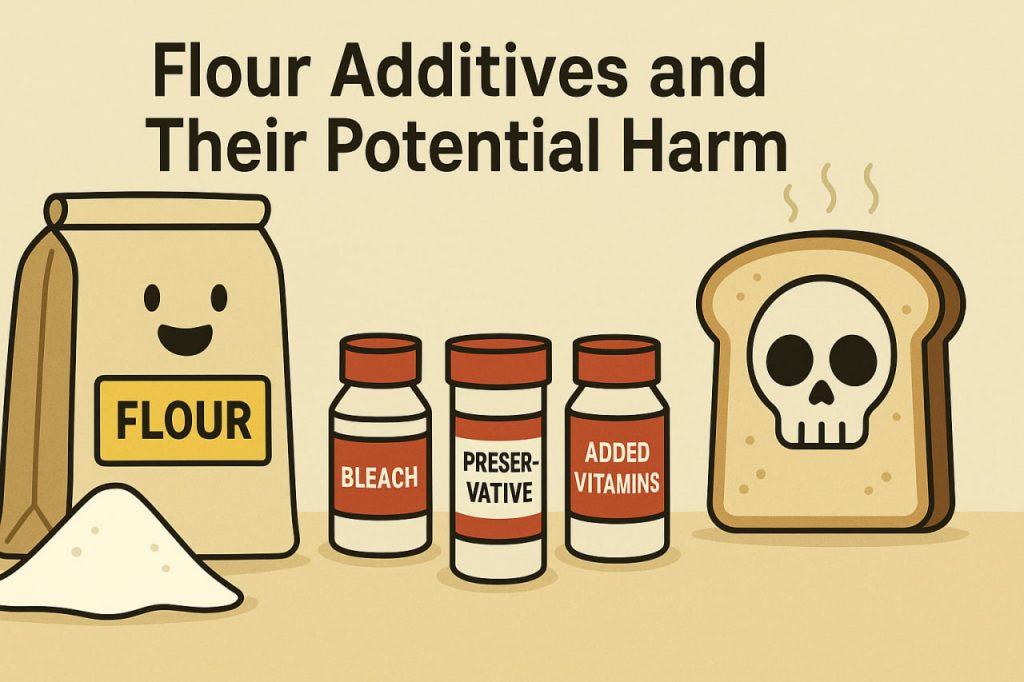Flour additives are substances added during processing to improve baking quality, extend shelf life, or enhance color. Common examples include bleaching agents, stabilizers, and fortifying nutrients. Food manufacturers use them to create flour that is consistent, easy to work with, and more appealing to consumers. However, while some additives serve useful purposes, others raise health concerns, especially when consumed regularly in large amounts.
Common Types of Flour Additives
The most widely used flour additives include:
- Bleaching agents (such as benzoyl peroxide, chlorine dioxide) to whiten flour and improve texture.
- Preservatives (like calcium propionate) to prevent mold growth.
- Enzymes to strengthen dough and improve volume.
- Nutrient fortifiers (iron, folic acid, B vitamins) added to combat nutrient deficiencies.
- Emulsifiers that improve dough elasticity and bread softness.
These substances vary greatly in their impact on human health, with some considered safe and others controversial.
Potential Health Concerns
While many flour additives are regulated and approved by health authorities, their long-term effects remain debated. Some bleaching agents, for example, may leave residues that irritate sensitive digestive systems. Preservatives like calcium propionate have been linked in some studies to headaches and behavioral changes in children. Excessive enrichment with synthetic vitamins can also cause imbalances if combined with dietary supplements. Moreover, processed flour with additives often loses natural nutrients and fiber compared to whole-grain alternatives.
Impact on Nutritional Value
Paradoxically, while fortification adds vitamins and minerals to flour, the refining process strips away much of its natural nutrition. Additives cannot fully replace the benefits of whole grains, which contain fiber, antioxidants, and phytonutrients. Relying heavily on additive-enriched white flour products may contribute to poor dietary balance, weight gain, and chronic conditions such as type 2 diabetes and cardiovascular disease.
Regulations and Safety Standards
Different countries regulate flour additives in different ways. Organizations like the FDA in the United States and the EFSA in Europe set limits on acceptable levels. However, some additives banned in one country may still be permitted in another, reflecting uncertainty in scientific data. Consumers are often unaware of what is added to their flour, as labeling may not always be clear. This lack of transparency increases public concern about safety.
Choosing Safer Alternatives
To reduce risks, nutrition experts recommend choosing whole-grain or minimally processed flours without chemical bleaching or unnecessary preservatives. Organic flour is less likely to contain synthetic additives. Reading ingredient labels carefully and limiting processed baked goods can also help reduce additive intake. Ultimately, the safest strategy is to focus on natural sources of nutrients rather than relying on fortified refined flour.
Conclusion
Flour additives play a significant role in modern food production, improving shelf life and baking properties. However, their potential health risks cannot be ignored, particularly when they replace natural nutrients and encourage reliance on refined products. While regulations ensure basic safety, consumers benefit most from awareness and careful food choices. Prioritizing whole and less-processed flours is a healthier approach to balancing convenience with nutrition.
Glossary
- Flour additives – substances added to flour to improve baking quality, shelf life, or nutrition.
- Bleaching agents – chemicals that whiten flour and modify its texture.
- Preservatives – substances that prevent spoilage from mold and bacteria.
- Enzymes – proteins added to enhance dough performance.
- Fortification – process of adding vitamins and minerals to food.
- Whole grain – grain containing all natural parts: bran, germ, and endosperm.


